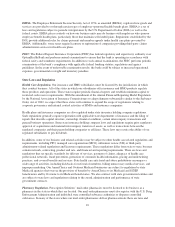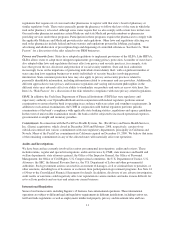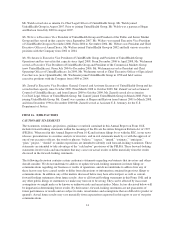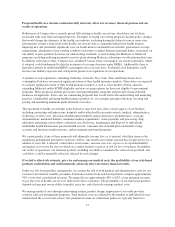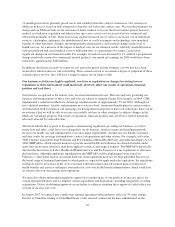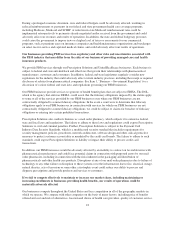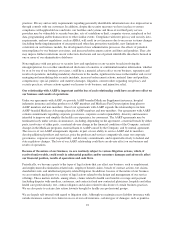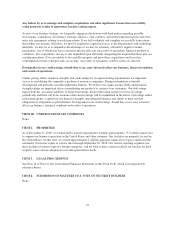United Healthcare 2009 Annual Report Download - page 17
Download and view the complete annual report
Please find page 17 of the 2009 United Healthcare annual report below. You can navigate through the pages in the report by either clicking on the pages listed below, or by using the keyword search tool below to find specific information within the annual report.Proposed health care reforms could materially adversely affect our revenues, financial position and our
results of operations.
Both houses of Congress have recently passed bills relating to health care reform, which have not yet been
reconciled with each other and signed into law. Examples of health care reform proposals include policy changes
that would change the dynamics of the health care industry, including having the federal or one or more state
governments assume a larger role in the health care system such as competing with private health insurers,
imposing new and potentially significant taxes on health insurers and health care benefits, guaranteed coverage
requirements, elimination of pre-existing condition exclusions or annual lifetime maximum limits, restrictions on
our ability to price products based on our underwriting standards, or restructuring the Medicare or Medicaid
programs, including reducing payments to private plans offering Medicare Advantage over the intermediate term.
In addition, from time to time, Congress has considered various forms of managed care reform legislation, which,
if adopted, could fundamentally alter the treatment of coverage decisions under ERISA. Additionally, there is
legislative interest in modifying ERISA’s preemptive effect on state laws. If adopted, such limitations could
increase our liability exposure and could permit greater state regulation of our operations.
A number of state legislatures, including California, Colorado, New York, Ohio and Pennsylvania, have
contemplated but have not enacted significant reform of their health insurance markets. Other states are expected
to consider significant reform of their health insurance markets as well as more modest reforms aimed at
expanding Medicaid and/or SCHIP eligibility and new coverage options for those not eligible for government
programs. These proposals include provisions affecting both public programs and privately financed health
insurance arrangements. States also are considering proposals that would reform the underwriting and marketing
practices of individual and group health insurance products by, for example, placing restrictions on rating and
pricing and mandating minimum medical benefit cost ratios.
The enactment of health care reforms at the federal or state level may affect certain aspects of our business,
including contracting with physicians, hospitals and/or other health care professionals; medical, administrative,
technology or other costs; physician reimbursement methods and payment rates; premium rates; coverage
determinations; mandated benefits; minimum medical expenditures; claim payments and processing; drug
utilization and patient safety efforts; collection, use, disclosure, maintenance and disposal of individually
identifiable health information; personal health records; consumer-driven health plans and health savings
accounts and insurance market reforms; and government-sponsored programs.
We cannot predict if any of these proposals will ultimately become law, or, if enacted, what their terms or the
regulations promulgated pursuant to such laws will be. Any health care reforms enacted may be phased in over a
number of years but, if enacted, could reduce our revenues, increase our costs, expose us to expanded liability
and require us to revise the ways in which we conduct business or put us at risk for loss of business. In addition,
our results of operations, our financial position, including our ability to maintain the value of our goodwill, and
cash flows could be materially adversely affected by such changes.
If we fail to effectively estimate, price for and manage our medical costs, the profitability of our risk-based
products could decline and could materially adversely affect our future financial results.
Under our risk-based product arrangements, we assume the risk of both medical and administrative costs for our
customers in return for monthly premiums. Premium revenues from risk-based products comprise approximately
90% of our total consolidated revenues. We generally use approximately 80% to 85% of our premium revenues
to pay the costs of health care services delivered to these customers. The profitability of our risk-based products
depends in large part on our ability to predict, price for, and effectively manage medical costs.
We manage medical costs through underwriting criteria, product design, negotiation of favorable provider
contracts and care management programs. Total medical costs are affected by the number of individual services
rendered and the cost of each service. Our premium revenue on commercial policies is typically fixed for a
15







